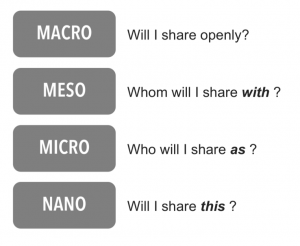For Week Two’s topic on open learning – sharing and openness, my team and I unpacked the concept of “openness” in the context of open educational resources (OER), in which we identified what OER is, its benefits, and challenges. As a university tutor who capitalises on social interactions in order to make learning for my students meaningful, I wanted to figure out whether I was really open when I’m dealing with them, especially since there is a fine line between ensuring my students get the best learning experience that I could possibly offer, whilst maintaining privacy and drawing boundaries for the sake of my own sanity. Thus, I decided to explore this route on my own.
While looking through articles to see how students and staff perceive openness in education, I chanced upon this gem by Catherine Cronin (2018), titled Balancing privacy and openness, using a lens of contextual integrity. In this article, she explained that balancing privacy and openness among staff and students is “complex, personal, contextual, and continually negotiated” (p. 1), such as deciding on which communication channels to use, and whether they would consider the student a friend. In essence, she establishes that individuals decide on the level of openness through a four level model, as shown below:

After reading this article, I thought of how I would decide (albeit unconsciously) and to what extent I have been “open” about sharing information with my students. I do meet with students for consultations to provide additional scaffolding for their written assignment, usually in the form of verbal and written feedback. They tend to seek further clarification on the task, and ask me questions on how their draft could be improved. Likewise, I always made use of this opportunity to speak to them about their work, as students tend to react positively to verbal feedback (Agricola, Prins, & Sluijsmans, 2020).
Here is my thought process on providing feedback on students’ essay as I try to apply Cronin’s (2018) model. When queried, I would choose to share my opinion as I believe it will benefit them (nano), and it is my role as the tutor (micro) to give feedback to students (meso) who need it. However, as each essay is on a case-by-case basis, I would only share my thoughts with the specific student asking for feedback, and not openly to others (macro) to respect the student’s privacy and to save face. If I feel that the same feedback applies to other students’ essays (e.g. something I forgot to address in class), I would filter the comment so that it can be shared openly to other students without attributing it to the original writer.
All in all, I found this model useful for evaluating the concept of openness when deciding who I would share information with, and how I can package it in a way that it is acceptable. I’m certain that this is relevant as we become more mindful of maintaining student privacy in an already open world.
References:
- Agricola, B. T., Prins, F. J., & Sluijsmans, D. M. (2020). Impact of feedback request forms and verbal feedback on higher education students’ feedback perception, self-efficacy, and motivation. Assessment in Education: Principles, Policy and Practice, 27(1), 6–25. https://doi.org/10.1080/0969594X.2019.1688764
- Cronin, C. (2018). Balancing privacy and openness, using a lens of contextual integrity [Paper presentation]. 11th International Conference on Networked Learning, Croatia. https://aran.library.nuigalway.ie/bitstream/handle/10379/7259/NLConf_2018_-_Cronin.pdf?sequence=1
8 Comments
Thanks JP for sharing the 4 level model (nano, micro, meso, macro) in our PBL group. It’s a useful way to think about openness as we interact with our students. JL
Appreciate it, JL!
Thank you for sharing this model with us. I find it to be very useful and informative!
Thanks, Vesna!
Hi JP! I really like you model and how you use it to apply it on students’ essays. I think it works very well.
Nice to see you here, Johanna!
Good application of the model. How would this work when asking students to offer peer feedback?
Hi Alastair, I guess it depends whether we plan to evaluate the quality of their feedback, or we just want them to be aware on the nuances of providing feedback, given the situation. Regardless, we want to expose students to the concept of “openness” when sharing feedback on appropriate channels.